Lovers of architecture and art in general have at their disposal an excellent showcase of Gaudí’s works scattered throughout the city of Barcelona. An exceptional collection of buildings and projects that span the stages and styles of his entire professional career. Discover the works of Antoni Gaudí that you can visit in Barcelona.
Book your skip-the-line guided tour
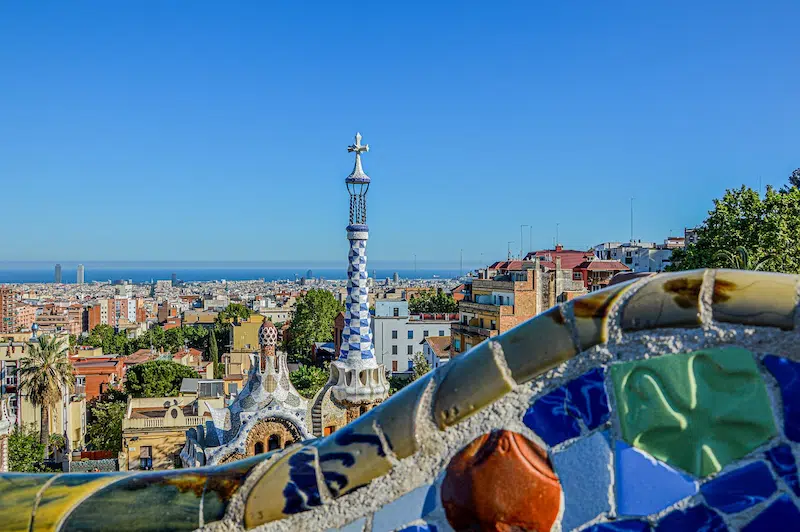
Table of Contents
- Gaudí in Barcelona
- The Sagrada Familia Basilica
- Casa Batlló
- Casa Milà – La Pedrera
- Park Güell
- Gaudí House Museum
- Casa Vicens
- Palau Güell
- Pavilions at Finca Güell
- Torre Bellesguard
- Casa Calvet
- Teresian School
- Miralles Gate
- Minor Projects
- Near the City of Barcelona
- Church at Colonia Güell
- Casa Vicens Waterfall
- Güell Wineries
- Location Map
All of Gaudí’s Works in Barcelona
Here you will find all the references to Antoni Gaudí in Barcelona. The most iconic and well-known works, as well as those projects that often go unnoticed because they were minor commissions or the architect’s earliest works. We also include some works located a short distance from the Catalan capital.
You’ll also find the necessary information to visit Gaudí’s most iconic works in the City of Counts, along with a location map.
The Sagrada Familia Basilica
The Sagrada Familia is undoubtedly the project that has propelled Gaudí into posterity. A grand temple where many of the brilliant architect’s teachings and proposals come to life. We won’t go into extensive explanations here since, on this website, VisitarSagradaFamilia.com, you have all the information about its architecture, tickets, schedules, or how to get there. But once again, we affirm that it is a marvelous and monumental work, an absolute must-see on a trip to Barcelona City.
You probably already know that it is still under construction, primarily funded by temple admission tickets, but its definitive completion is getting closer every day.
Casa Batlló
This iconic residence, built between 1904 and 1906, stands as a striking testament to the creative genius and innovative vision of the renowned Catalan architect along the bustling Passeig de Gràcia in the heart of Barcelona.
What makes Casa Batlló truly one-of-a-kind is its breathtaking façade, tinged with surrealistic echoes. Drawing inspiration from nature and organic shapes, it seems to meld seamlessly with Gaudí’s imagination. The building is defined by its flowing, wavy structure and bone-shaped balconies that evoke a sense of motion and fluidity. The vivid colors and intricate textures of the ceramic mosaics cladding the façade lend a dash of whimsy and charm to this architectural masterpiece.
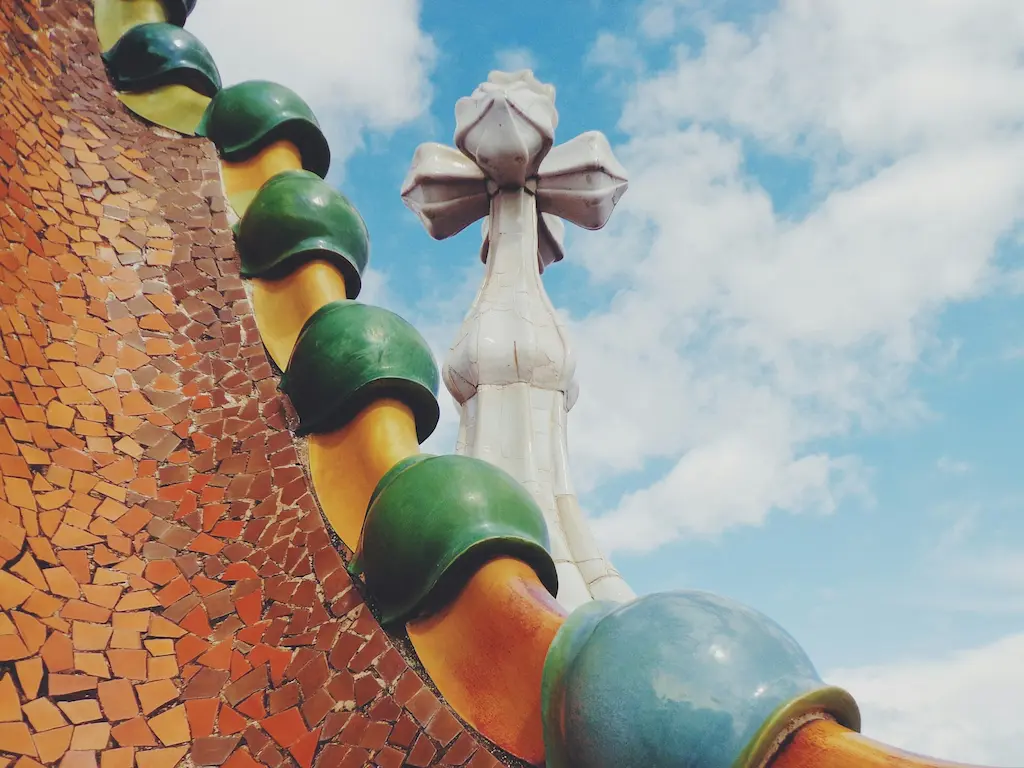
The wonders continue inside, where stepping into Casa Batlló unveils a world brimming with meticulously crafted details. The lobby, featuring a stunning spiral staircase, showcases Gaudí’s remarkable talent for blending form and function. Natural light streams through stained-glass windows, crafting a warm and immersive atmosphere. The wrought iron accents on railings and doors add an artistic, ornamental flair perfectly in tune with the Modernist style.
Casa Batlló also hosts an exhibition highlighting Antoni Gaudí’s life and work, offering visitors a deeper glimpse into the Catalan genius. From models and sketches to historical photographs, the display lets you marvel at Gaudí’s creative mind and his groundbreaking approach to architecture. Visiting Casa Batlló leaves no one unmoved and is a must-see stop for Gaudí enthusiasts in the Catalan capital.
Casa Milà – La Pedrera
Casa Milà, also known as La Pedrera, is another architectural masterpiece created by Antoni Gaudí in the heart of Barcelona. Built between 1906 and 1912, this structure is a testament to Gaudí’s avant-garde vision and unique creativity.
One of the most distinctive features of La Pedrera is its wavy, sculptural façade. The curved, organic shapes, once again evoking nature, combine with a variety of materials, including stone and iron, creating a surreal and fascinating appearance. The wrought iron balconies, with their twisted and unique design, add an artistic and functional touch to the building.
The interior of La Pedrera is equally impressive. The building features a central courtyard where natural light penetrates the space through skylights and reflects off the curved walls clad in white ceramic. The rooms and apartments showcase Gaudí’s characteristic attention to detail and imagination.
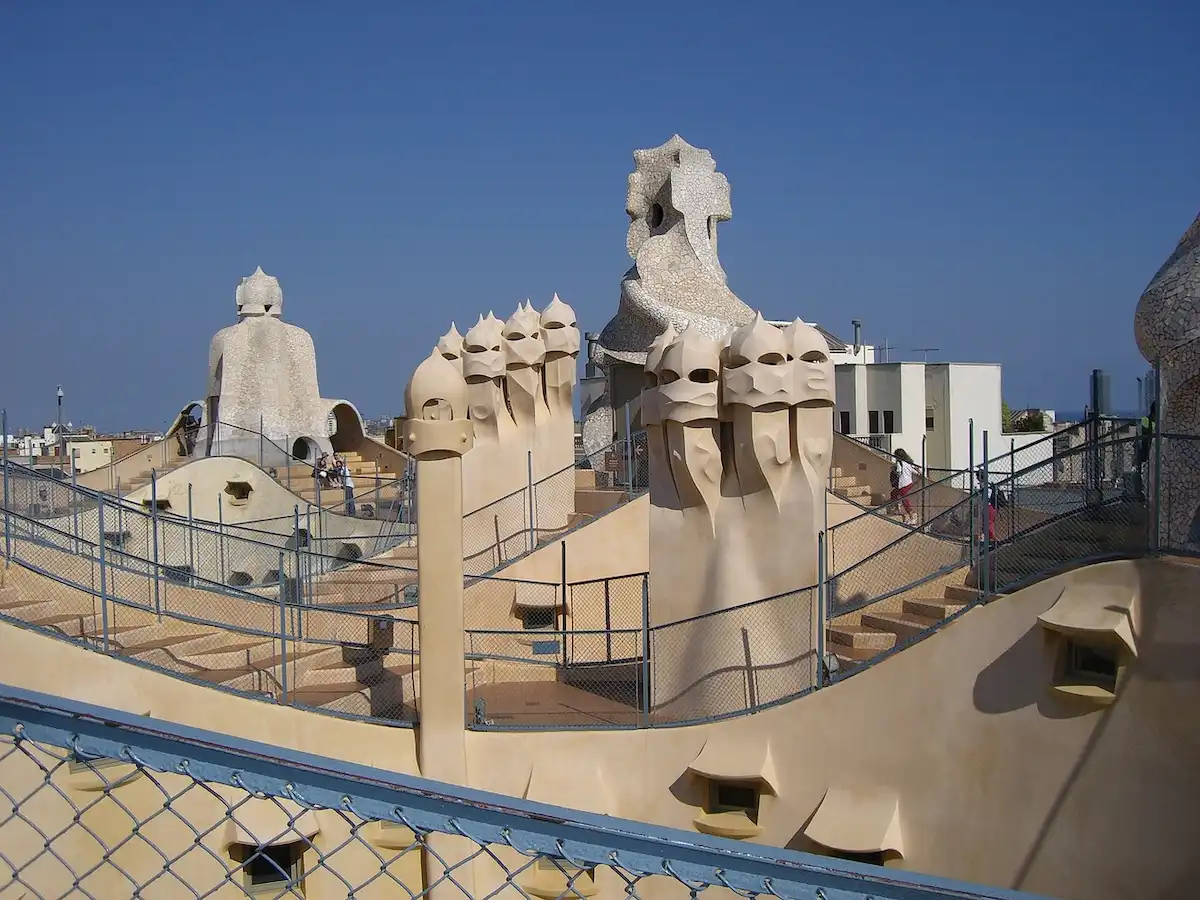
One of the most famous elements of La Pedrera is its rooftop, which offers a panoramic view of Barcelona and the stately Passeig de Gràcia. Crowned with sculptural chimneys covered in mosaics that resemble strange and fantastical figures, La Pedrera adds a touch of whimsy to the orthogonal urban landscape of the Eixample district. Undoubtedly another gem of Gaudí’s architecture in Barcelona; visiting La Pedrera is a must for anyone spending a few days in Barcelona.
We recommend the Barcelona Digital Pass option called “3 Houses of Gaudí,” which allows you to visit Casa Batlló, La Pedrera, and Casa Vicens with a single ticket.
See the BCN Digital Pass – “3 Houses of Gaudí” Tickets
Park Güell
In 1900, Gaudí was commissioned to design an exclusive residential development on the outskirts of Barcelona. The client was none other than the wealthy Catalan businessman Eusebi Güell, who had previously worked with the architect on the Colonia Güell, some wineries near Sitges, and his new residence known as Palau Güell. Palau means palace in catalan.
The project didn’t go as planned, and only two of the sixty houses originally envisioned were built. This business failure was likely necessary for Park Güell to later be declared a UNESCO World Cultural Heritage site in 1984.
One of the most notable features of Park Güell is its structures and architectural solutions, such as the mosaic-covered benches, slanted columns, and ceramic-decorated ceilings. These elements reflect Gaudí’s distinctive style, with his nature-inspired curved and organic forms so representative of Modernism in Barcelona.
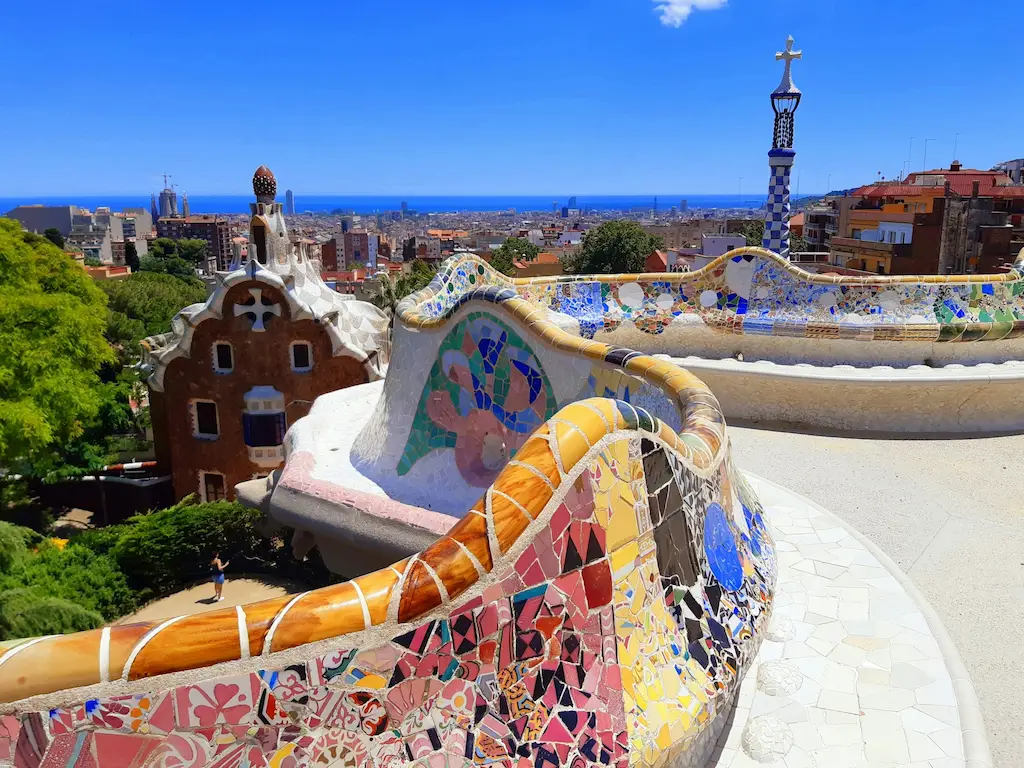
The park also boasts a wide variety of lush gardens, winding paths, and panoramic terraces offering stunning views of the city with the Mediterranean Sea on the horizon. The gardens are harmoniously designed, integrating trees, flowers, and native Mediterranean species.
At Park Güell, you can stroll and even pose for a photo, if you’d like, at the famous Dragon Staircase, adorned with a beautiful, colorful mosaic dragon. This iconic figure has become one of the park’s most recognizable symbols, not to mention the Hypostyle Room or the main entrance with its gatehouse pavilions.
Park Güell + Sagrada Familia Tickets (Official Provider)
Gaudí House Museum
Gaudí established his residence in Park Güell in 1906 and lived there for twenty years until he moved to the Sagrada Familia in 1925 to devote himself entirely to his grand final project. The house was designed by his friend and collaborator Francesc Berenguer i Mestres and was built as a promotional model and example for future constructions in Park Güell—what we now call a show home.
Since 1963, the Gaudí House Museum has been open to the public, aiming to spread awareness and serve as an international reference for all those interested in Antoni Gaudí. There, we can recreate the architect’s austere lifestyle and view objects, furniture, and documents related to his life.
It is currently managed by the Foundation of the Construction Board of the Expiatory Temple of the Sagrada Familia, the former home where the influential Modernist architect conceived and sketched his great projects.
Casa Vicens
Casa Vicens, designed by Antoni Gaudí, is an architectural gem located in the Gràcia neighborhood (see its location on the map) of Barcelona. Built between 1883 and 1885, it is considered one of the first masterpieces of Catalan Modernism. In his first major commission, Gaudí stunned everyone with the talent poured into the building, a prelude to his later successes.
The house was designed as a summer residence and features influences from Mudéjar and Oriental architecture. Its colorful façade stands out, adorned with ceramic tiles depicting natural and geometric motifs. It originally had a lush garden that added beauty and tranquility to the ensemble. Over the years, the plot was reduced to its current size, resulting in the removal of a curious fountain, which was later rebuilt at the Museu de les Aigües in the nearby town of Cornellà de Llobregat.

One of the most significant features of Casa Vicens is the innovative use of different materials, such as ceramic, wrought iron, and stone, harmoniously combined with contrasting colors. The interior is equally impressive, with elaborate details and unique decorative elements reflecting Gaudí’s boundless creativity as a recent graduate. A prime example is the smoking room with its polychrome plaster muqarnas ceiling in blue, green, and gold tones.
Casa Vicens was declared a UNESCO World Heritage site in 2005.
Palau Güell
Palau Güell is an impressive residence (a palace) located at Nou de la Rambla 3-5, in Barcelona’s Raval neighborhood. Built between 1886 and 1890, it was the first major commission from industrialist Eusebi Güell to Gaudí after the Pavilions at Fina Güell.
One of the standout features of Palau Güell is its innovative and distinctive architecture, framed within Gaudí’s Orientalist period. The Casa Vicens referenced here also fits this trend. The main façade features a sober and elegant design, while inside, Gaudí created surprising spaces filled with ornamental details crafted by the finest artisans of the time.
The building boasts a series of unique architectural elements, such as the iconic rooftop with its famous extravagantly shaped chimneys, which have become a hallmark of Gaudí’s works.
The interior of Palau Güell is equally inspiring. Highlights include the reception room, the main hall, and the basement, where a stable for horses is located. Each space is carefully designed with aesthetic and functional criteria.
An interesting curiosity is that Palau Güell features an innovative lighting system for its time. Gaudí used strategically placed skylights and light wells to maximize natural light and create unique lighting effects inside.
Eusebi Güell lived in the estate with his wife and daughters until 1906. They then moved to Casa Larrard within Park Güell, where they became neighbors with Gaudí. In 1984, UNESCO declared the building a World Heritage site.
Pavilions at Finca Güell
Another notable work by Gaudí in Barcelona, under the patronage of Eusebi Güell, is simply known as the Güell Pavilions, located in the Pedralbes neighborhood near the Royal Palace of Barcelona.
This project involved the perimeter wall and service buildings of a former estate owned by the businessman Güell. Despite the modest nature of the commission (1887), Gaudí shines here too with the architecture of the gatehouse pavilions and, especially, one of the estate’s wrought iron gates.
The famous gate is a spectacular grille featuring a winged dragon with glass eyes, representing Ladon, the guardian of the Garden of the Hesperides. The blacksmith tasked with bringing Gaudí’s fantastical vision to life was Joan Oñós, whose work still inspires admiration today.
Torre Bellesguard
Torre Bellesguard is a work designed by Antoni Gaudí between 1900 and 1909. Unlike many of Gaudí’s more famous works, this tower features straight forms and an aesthetic inspired by the medieval castle of Martin the Humane. This architectural singularity places it halfway between Gothic and Modernism, making it unique among Gaudí’s works and turning it into a special visit.
The history of Bellesguard is deeply rooted in Catalonia’s past. Its origins date back to the Middle Ages when Martin the Humane named the site and decided to build his regular residence there. Additionally, this historic site played a significant role in Catalan history, serving as a hideout for Serrallonga, one of Catalonia’s most famous bandits, after his activities in the city.
The name “Bellesguard” comes from its strategic location (see its position on the map of Gaudí’s works in Barcelona), offering stunning panoramic views, and means “beautiful view” or “good shelter” in Catalan. The estate’s gardens still preserve part of the medieval structure that inspired Gaudí.
Notably, both Torre Bellesguard and the Church at Colonia Güell represent works where Gaudí experimented with innovative architectural solutions that he later applied to his most famous work, the Sagrada Familia. These lesser-known works also offer insight into Gaudí’s creative genius and his ability to adapt to different architectural styles based on historical context and the needs of each project he undertook.
Casa Calvet
Located in the heart of Barcelona, in the Eixample district designed by Ildefonso Cerdà, this house is an example of Gaudí’s skill in designing a building between party walls, with clear urban and regulatory constraints.
This masterpiece was built between 1898 and 1900 as a residence for the Calvet family. At first glance, Casa Calvet pays homage to the Catalan neo-Gothic style, with a façade that features notable symmetry and ornamental details characteristic of Gaudí’s renowned style. Upon closer inspection, we can appreciate countless details in the main tribune, referencing the owners’ personal tastes, or a wrought iron door knocker at the main entrance crafted by Joan Oñó.
The interior of Casa Calvet is a work of art in itself. The decorative details, Te stained glass, and the layout of the spaces are a testament to Gaudí’s vision of creating environments that combine residential comfort with avant-garde aesthetics. Currently, part of the house hosts a restaurant, allowing visitors to enjoy the experience of being immersed in Gaudí’s work while savoring delicious dishes.
A curious fact: Barcelona City Council designated Casa Calvet as the best building of 1900, and it is the only award Gaudí received during his entire lifetime.
Teresian School
The Teresian School is a must-visit stop for those thoroughly exploring the fascinating work of the Modernist genius in Barcelona. Located in the Sant Gervasi neighborhood in the northern part of the city, this building stands out at first glance for its decorative simplicity and use of brick.
Gaudí took on the responsibility for this project when the building’s foundations were already in place. However, in his characteristically innovative style, he decided to retain the original square layout, giving it the air of a castle in reference to one of Saint Teresa of Jesus’s works, “The Interior Castle.” Though the budget was tight, Gaudí managed to create a monumental construction that combines the use of brick instead of stone, plaster interior walls, and a sober yet striking decoration.
As is typical in Gaudí’s works, the Teresian School reflects his genius and deep symbolism. The building features parabolic arches, helical columns, wrought iron grilles, and four-armed crosses, elements that are a distinctive mark of the architect. Completed in 1889, this Modernist work has been considered a Cultural Heritage of National Interest since 1969.
Miralles Gate
In the Sarrià neighborhood, very close to the Güell Pavilions (see the location map), we find another Gaudí work worth a visit: the gate and walls of the Miralles Estate.
Hermenegild Miralles commissioned Gaudí for this work in 1901, shortly after purchasing the estate from Güell. Today, part of the perimeter wall and a majestic gate with a prominent lobed arch still stand. Here, you’ll find stylistic references so characteristic of Gaudí, such as nature-inspired forms and the use of trencadís.
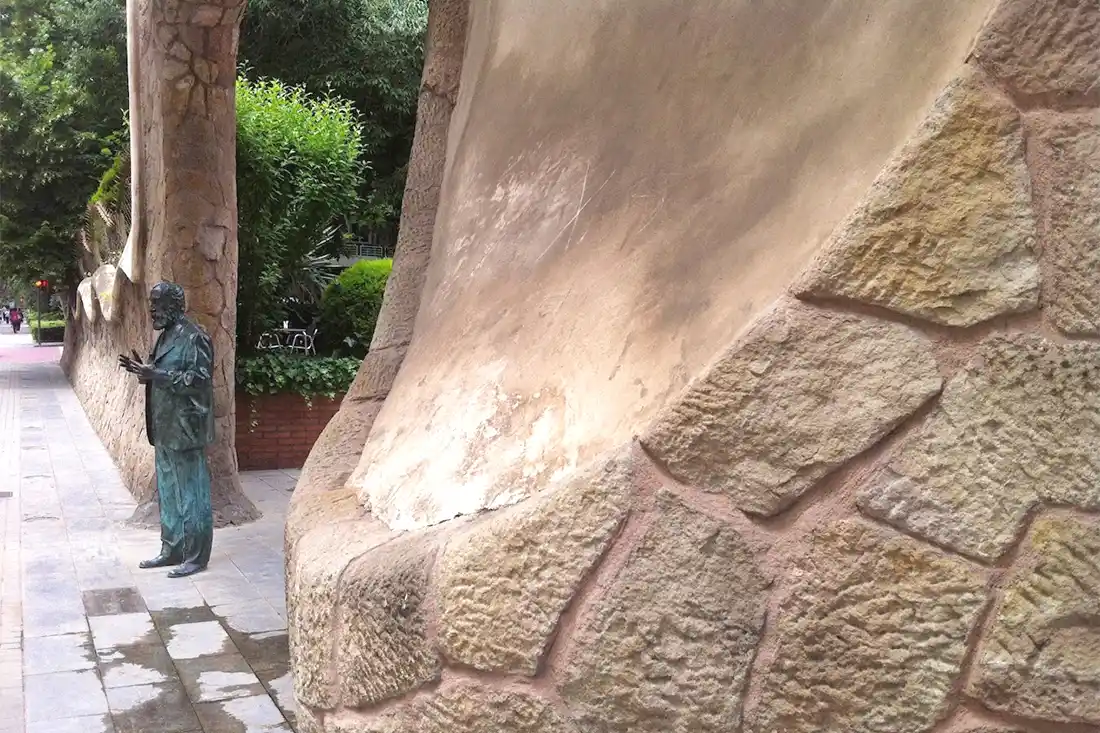
Standing next to the former entrance of the Miralles Estate today, you can find a life-sized statue of Gaudí created by sculptor Joaquim Camps. Thus, at the Miralles Gate, you have the chance to come face-to-face with the genius architect.
Skip the Lines at the Sagrada Familia
Get your Sagrada Familia tickets in advance and skip the endless lines at the entrance.
More Gaudí Works in Barcelona
To complete the list of all the Gaudí works you can visit in Barcelona, we must mention three additional creations. These are minor works, though they are of sufficient interest—after all, they are the works of a genius!
Street Lamps at Plaça Reial and Pla de Palau
The design of the street lamps was a commission from Barcelona City Council in 1878 for an Antoni Gaudí who, at that time, was not yet officially an architect.
He designed two models, differing in having either six or three arms and in their top finial. In both, the shaft is cast iron supported by a marble base.
Two of Gaudí’s six-armed street lamps, featuring an allegory of commerce, are still in operation (now with electric power) in the central Plaça Reial, next to Las Ramblas.
Of the three-armed model, two examples remain standing and are located in Pla de Palau (see on the Barcelona map). The lamps’ excellent design and durability stand out, despite exposure to weather and the wear of urban furniture.
Monumental Waterfall at Parc de la Ciutadella
The final point among Gaudí’s works we can visit without leaving Barcelona is the pleasant Parc de la Ciutadella. There, one of the attractions is its lake and the sculptural ensemble presiding over it, known as the Monumental Waterfall.
The waterfall project was authored by Josep Fontseré, while it is known that Gaudí was responsible for the hydraulic design. Some sources see the hand of a young Gaudí in the design of certain decorative elements of the waterfall, such as the rocks or iron masts.
Gaudí Works Near Barcelona
While the bulk of Gaudí’s production is located in the Catalan capital, there are fascinating works to visit nearby. A half-day excursion is more than enough to explore the Church at the Colonia Güell, the original Casa Vicens waterfall, or the Güell Wineries in Sitges.
Church of the Colonia Güell
Located in Santa Coloma de Cervelló, Barcelona, the Crypt of the Colonia Güell stands as an integral part of an ambitious industrial project conceived by Gaudí’s patron, Eusebi Güell, in 1890.
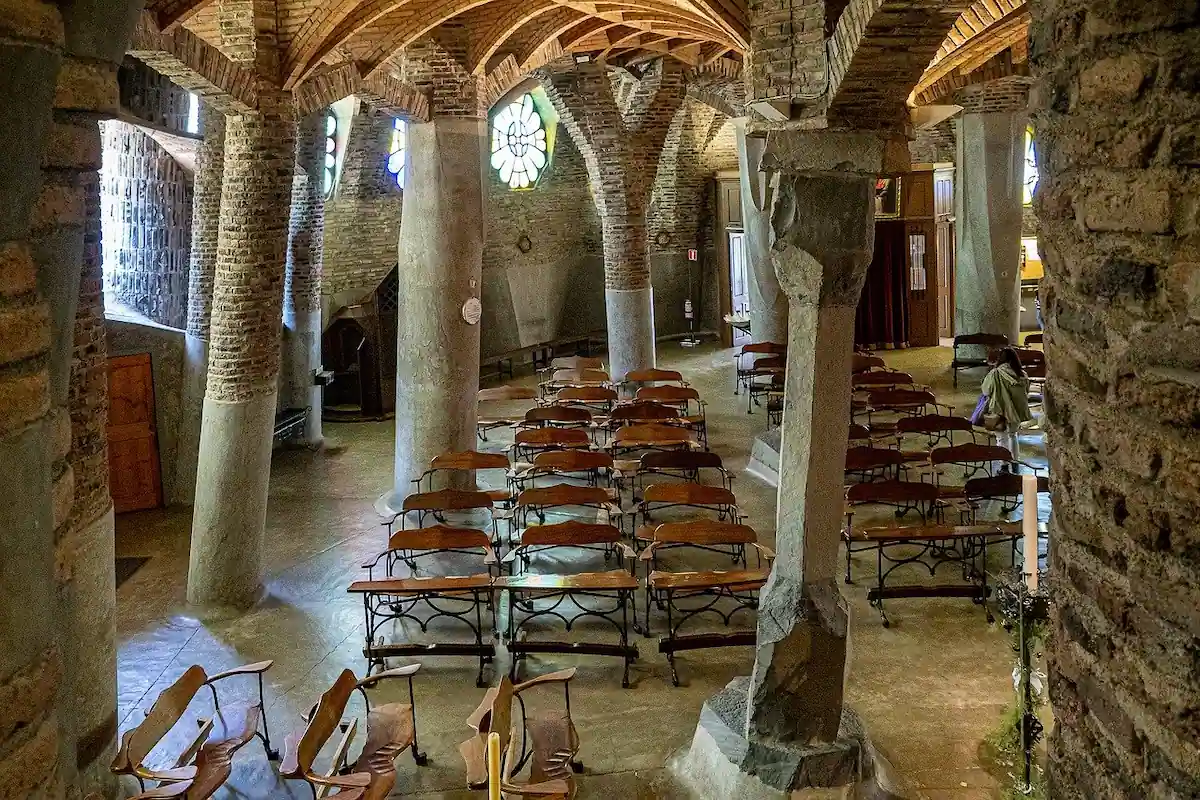
True to his innovative style, Gaudí took on the challenge of designing the church for this textile colony, retaining the original square layout. However, his vision led him to create a building that evokes a castle and harmonizes with the unconventional architecture of the workers’ housing and the surrounding natural environment. Though resources were initially unlimited, Gaudí transformed modest materials like brick and stone into a masterpiece that stands out for its uniqueness and symbolism. It also excels for encompassing nearly all of Gaudí’s architectural innovations.
The Güell Crypt isn’t exactly a crypt since it isn’t underground; its windows open to the street, giving it a unique appearance. The lower church, with a star-shaped polygonal floor plan, features a central vault resting on four basalt columns. Inside, light filters magically through stunning stained glass windows designed by Josep M. Jujol. The rustic, monochromatic atmosphere resembles a natural grotto, where darkness is interrupted by bursts of polychromatic light. The crypt is a perfect example of the fusion of natural and religious elements, and its structure is based on a unique stereostatic model that Gaudí designed with unparalleled mastery.
Though the Crypt of the Colonia Güell was never completed according to Gaudí’s original plans, its legacy endures as a milestone of original and expressive architecture. In 1990, it was declared a Cultural Asset of Interest-Historical Ensemble, and in 2005, UNESCO added it to its World Heritage list.
Visiting Gaudí’s Crypt and exploring the Colonia Güell is ideal for understanding the historical context in which Antoni Gaudí lived.
Casa Vicens Fountain
The Fountain or waterfall of Casa Vicens was originally located in the expansive gardens of the residence of the same name. The waterfall was a refreshing feature in the summer house, a whim executed with Gaudí’s creativity. Over time, the family sold parts of the Casa Vicens grounds, and the fountain was demolished.
Fortunately, it was later reconstructed based on the plans and notes left by the architect. The exact replica can be visited at the fascinating Museu de les Aigües in Cornellà de Llobregat, where you can walk inside and listen to the sounds of dripping water and trickling streams.
Güell Wineries
The Güell Winery, located by the sea in El Garraf, just minutes from Barcelona, is a captivating Modernist architectural ensemble created by Antoni Gaudí and his disciple Francesc Berenguer i Mestres.
This was another commission from the industrialist and patron Eusebi Güell to what became his preferred architect. Initially conceived as a hunting pavilion, the idea evolved into the construction of a winery due to the vineyards Güell owned in the Garraf area.
This masterpiece, built between 1895 and 1901, blends stone, brick, and wrought iron to create a structure that evokes the essence of a medieval fairytale castle. Modernist architecture manifests in parabolic lines, asymmetrical solutions, and irregular forms that define its unique aesthetic—all within Gaudí’s so-called neo-Gothic period.
Though there has been some controversy over its authorship, an original plan displayed at the Arxiu Històric de Sitges bears Gaudí’s signature, confirming his significant contribution to this work of art.
Map of All Gaudí Projects in Barcelona
Enlarge the Map with All of Gaudí’s Masterpieces in Barcelona
The Catalan capital holds the highest concentration of works by the renowned architect. Check the map to locate all of Gaudí’s projects in Barcelona.